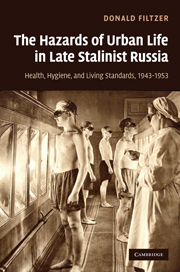Book contents
- Frontmatter
- Contents
- List of figures
- List of maps
- List of tables
- Preface and acknowledgements
- List of terms and abbreviations
- 1 Map of the regions covered in the book, from Moscow in the west to Kemerovo oblast' in Western Siberia
- 2 The Volga and Kama River networks
- 3 Moscow and Moscow oblast'
- 4 The Urals and its major rivers
- The Kuzbass and the River Tom'
- Introduction
- 1 The impossible task: keeping cities clean
- 2 Water
- 3 Personal hygiene and epidemic control
- 4 Diet and nutrition: the 1947 food crisis and its aftermath
- 5 Infant mortality
- Conclusion
- Bibliography
- Index
3 - Personal hygiene and epidemic control
Published online by Cambridge University Press: 06 July 2010
- Frontmatter
- Contents
- List of figures
- List of maps
- List of tables
- Preface and acknowledgements
- List of terms and abbreviations
- 1 Map of the regions covered in the book, from Moscow in the west to Kemerovo oblast' in Western Siberia
- 2 The Volga and Kama River networks
- 3 Moscow and Moscow oblast'
- 4 The Urals and its major rivers
- The Kuzbass and the River Tom'
- Introduction
- 1 The impossible task: keeping cities clean
- 2 Water
- 3 Personal hygiene and epidemic control
- 4 Diet and nutrition: the 1947 food crisis and its aftermath
- 5 Infant mortality
- Conclusion
- Bibliography
- Index
Summary
Given the state of housing and urban sanitation as well as limited access to water, maintaining personal hygiene required a monumental effort. People were exposed to dirt at work, in the streets, and around the home, but had few resources for keeping themselves and their families clean. In the previous chapter I noted that, outside Moscow, only a minority of buildings had indoor running water. People had to haul cold water up in buckets from street pumps. Heating water was not easy, since most people still relied on wood-burning stoves and fuel was in short supply right up until the end of the 1940s. Only in Moscow was there a concerted effort to install gas into people's flats, and even this campaign achieved significant results only in the early 1950s. To make matters worse, the country suffered a serious soap shortage, which began to ease only at the very end of the 1940s. Undoubtedly people did wash at home, but to bathe properly they relied on the famous Russian banya, or bathhouse. The banya was not a bathhouse in the British sense. There were no bathtubs. Instead there were cubicles with taps of hot and cold water and a basin, which people would use to pour water over themselves, almost like a makeshift shower. Bathing in this way was a serious business, and bathhouses assumed that each bather would spend around an hour scrubbing themselves thoroughly with soap and a loofa (mochalka) and rinsing themselves clean.
- Type
- Chapter
- Information
- The Hazards of Urban Life in Late Stalinist RussiaHealth, Hygiene, and Living Standards, 1943–1953, pp. 127 - 162Publisher: Cambridge University PressPrint publication year: 2010



